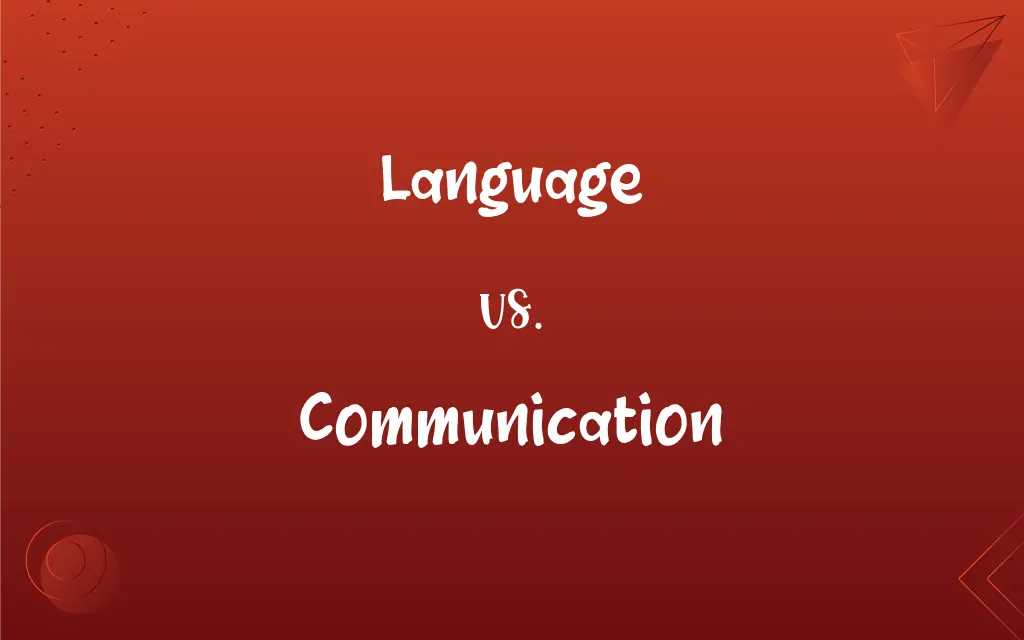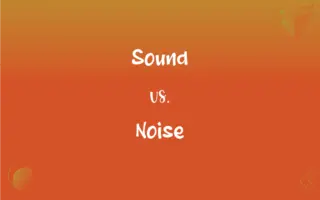Language vs. Communication: What's the Difference?
Edited by Aimie Carlson || By Harlon Moss || Updated on November 16, 2023
Language is a structured system of symbols and rules, while communication is the act of transmitting information.

Key Differences
Language and communication, while related, serve different functions in our interactions. Language represents a structured system of symbols, sounds, and rules employed to convey complex ideas and emotions. On the other hand, communication encompasses a broader spectrum, referring to the act of transferring information, feelings, or thoughts between individuals or entities.
Communication does not rely solely on language; it extends to gestures, facial expressions, and even silence. For example, animals use various forms of communication without necessarily having a defined language. Conversely, language is a specific subset of communication, one that humans have intricately developed for detailed expression.
In the realm of human interactions, language serves as one of the primary tools for communication. It enables us to share abstract concepts, narrate past events, and discuss potential futures. Nonetheless, communication can occur outside the boundaries of language, as seen in art, music, or a simple touch.
Different cultures have developed their own languages, each with its unique sounds, grammar, and vocabulary. However, the need for communication is universal. Every society, regardless of its language, seeks effective ways to relay messages, share stories, and understand each other.
Comparison Chart
Definition
A system of symbols and rules for communication.
The act of transmitting information.
ADVERTISEMENT
Scope
Subset of communication.
Encompasses a wider range of modes.
Mediums
Spoken, written, signed.
Spoken, written, non-verbal, visual, auditory, tactile.
Dependence on Humans
Mostly human-specific, with few exceptions like programming languages.
Universal among living beings.
Relation to Culture
Varies across cultures; each can have its own language.
Universal need across all cultures.
Language and Communication Definitions
Language
The method or system of communication used by a particular community or country.
Sign language is vital for the deaf community.
ADVERTISEMENT
Communication
A message conveyed through speech, writing, or signals.
He sent a communication to the team.
Language
The coding system used to program computers.
Python is a popular language among developers.
Communication
The act of conveying information.
Effective communication is key to understanding.
Language
Nonverbal means of expression.
Music is a universal language.
Communication
Means of sending or receiving information.
Digital communication has transformed our world.
Language
A system of communication using words in a structured manner.
English is a widely spoken language.
Communication
Social interactions to exchange information.
Face-to-face communication has its unique advantages.
Language
The style or types of words used by a person or group.
He had a very formal language in his letters.
Communication
The successful transmission of a message.
Their communication broke down during the argument.
Language
Communication of thoughts and feelings through a system of arbitrary signals, such as voice sounds, gestures, or written symbols.
Communication
The act of communicating; transmission.
Language
Such a system including its rules for combining its components, such as words.
Communication
The exchange of thoughts, messages, or information, as by speech, signals, writing, or behavior.
Language
Such a system as used by a nation, people, or other distinct community; often contrasted with dialect.
Communication
Interpersonal rapport.
FAQs
Why do we have different languages?
Languages evolve due to cultural, geographical, historical, and social factors, leading to diversity.
How many languages exist in the world?
There are approximately 7,000 languages, but the number is always changing due to language evolution and extinction.
Is body language a form of communication?
Yes, body language is a non-verbal form of communication.
What role does technology play in modern communication?
Technology facilitates faster, broader, and more diverse methods of communication, from texting to video conferencing.
Can communication occur without language?
Yes, communication can be through gestures, expressions, or other non-verbal means.
Can animals communicate without a language?
Yes, animals use various non-verbal methods for communication.
What is the primary purpose of language?
Language facilitates communication, allowing for expression, information sharing, and social interaction.
Why is non-verbal communication significant?
Non-verbal cues can carry emotion, context, and clarity, often complementing verbal communication.
Can art be a form of communication?
Yes, art can convey emotions, ideas, and messages, serving as a non-verbal form of communication.
How does culture influence language?
Culture shapes language through shared experiences, values, histories, and social norms.
How has technology influenced language evolution?
Technology has introduced new words, affected language spread, and even created spaces for new dialects (e.g., internet slang).
Is sign language universal?
No, there are various sign languages worldwide, each with its own vocabulary and grammar.
Is language essential for communication?
No, while language is a tool for communication, non-verbal methods can also convey messages.
What's the difference between a dialect and a language?
A dialect is a regional variation of a language, while a language is a broader system of communication.
How can one improve their communication skills?
Through practice, feedback, active listening, and understanding non-verbal cues.
Are programming languages true "languages"?
While different in function, programming languages have syntax and semantics, much like spoken languages.
Do all languages have a written form?
No, many languages are only spoken and lack a standardized writing system.
How do new languages form?
New languages often evolve from existing ones due to isolation, migration, or other socio-cultural factors.
Can one language be superior to another?
No, each language reflects its culture and has its own richness and value.
Why is clear communication essential in professional settings?
Clear communication prevents misunderstandings, ensures efficiency, and fosters a productive environment.
About Author
Written by
Harlon MossHarlon is a seasoned quality moderator and accomplished content writer for Difference Wiki. An alumnus of the prestigious University of California, he earned his degree in Computer Science. Leveraging his academic background, Harlon brings a meticulous and informed perspective to his work, ensuring content accuracy and excellence.
Edited by
Aimie CarlsonAimie Carlson, holding a master's degree in English literature, is a fervent English language enthusiast. She lends her writing talents to Difference Wiki, a prominent website that specializes in comparisons, offering readers insightful analyses that both captivate and inform.







































































